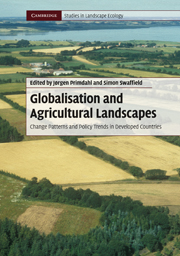Book contents
- Frontmatter
- Contents
- List of Contributors
- Preface
- 1 Globalisation and the sustainability of agricultural landscapes
- 2 Agricultural liberalisation, multifunctionality and the WTO: competing agendas for the future of farmed landscapes
- 3 Globalisation of agricultural landscapes: a land systems approach
- 4 Agricultural landscape changes through globalisation and biodiversity effects
- 5 Swiss agricultural policy reform: landscape changes in consequence of national agricultural policy and international competition pressure
- 6 Local landscape consequences of macro-scale policy reform: the New Zealand experiment
- 7 Rural landscape differentiation in the face of changing demands and policies: a typology of rural areas in Portugal
- 8 Globalisation and the local agricultural landscape: current change patterns and public policy interventions
- 9 From totalitarian to democratic landscapes: the transition in Estonia
- 10 Rural landscape change as a product of US federal policy
- 11 New approaches for urban–rural areas in Dutch spatial planning
- 12 Restoring agricultural landscapes in shrinking cities: re-inventing traditional concepts in Japanese planning
- 13 Globalisation and local agricultural landscapes: patterns of change, policy dilemmas and research questions
- Index
- References
1 - Globalisation and the sustainability of agricultural landscapes
Published online by Cambridge University Press: 05 June 2012
- Frontmatter
- Contents
- List of Contributors
- Preface
- 1 Globalisation and the sustainability of agricultural landscapes
- 2 Agricultural liberalisation, multifunctionality and the WTO: competing agendas for the future of farmed landscapes
- 3 Globalisation of agricultural landscapes: a land systems approach
- 4 Agricultural landscape changes through globalisation and biodiversity effects
- 5 Swiss agricultural policy reform: landscape changes in consequence of national agricultural policy and international competition pressure
- 6 Local landscape consequences of macro-scale policy reform: the New Zealand experiment
- 7 Rural landscape differentiation in the face of changing demands and policies: a typology of rural areas in Portugal
- 8 Globalisation and the local agricultural landscape: current change patterns and public policy interventions
- 9 From totalitarian to democratic landscapes: the transition in Estonia
- 10 Rural landscape change as a product of US federal policy
- 11 New approaches for urban–rural areas in Dutch spatial planning
- 12 Restoring agricultural landscapes in shrinking cities: re-inventing traditional concepts in Japanese planning
- 13 Globalisation and local agricultural landscapes: patterns of change, policy dilemmas and research questions
- Index
- References
Summary
The primary agent: two farmers in the same global space
When the young Danish dairy farmer, Svend Petersen, completed the last round of his large cowshed on a dark November night in 2007, New Zealand farmer Gordon Grey of the same age had just started his working day by checking the operation of his centre pivot irrigator. The two farmers are, as individuals and as members of two distinct societies, of course different. At this particular point in time their immediate situations were also quite different – Petersen was working indoors with dark, cold and wet weather outside, whereas Grey was enjoying an early spring morning.
Despite these practical differences the two farmers shared a number of common conditions. They both had smiles on their faces, as milk prices on the open global market had risen over the previous year and they had each received substantial increases in payments per kilogram of milk. Both farmers deliver their milk to dairy cooperatives which are among the largest multinational dairy corporations in the world. They are part of a global food network driven by corporate marketing strategies and benefit from economies of scale, but neither farmer has any influence on how their milk will be processed. At this moment in time they are also competitors, but it is quite possible that they may become partners, as the two companies are cooperating and may merge in the future.
- Type
- Chapter
- Information
- Globalisation and Agricultural LandscapesChange Patterns and Policy trends in Developed Countries, pp. 1 - 16Publisher: Cambridge University PressPrint publication year: 2010
References
- 3
- Cited by

